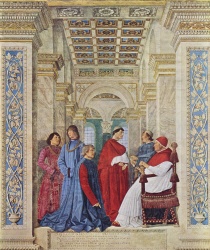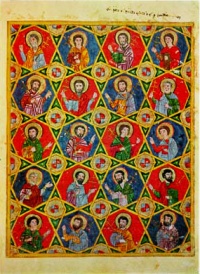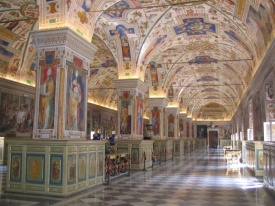Vatican Library
From Textus Receptus
Nick (Talk | contribs)
(New page: [[Pope Sixtus IV appoints Bartolomeo Platina prefect of the Vatican Library, fresco by Melozzo da Forlì, c. 1477 ([[Vatican Museums...)
Next diff →
Revision as of 21:58, 11 December 2009

The Vatican Library (Template:Lang-la) is the library of the Holy See, currently located in Vatican City. It is one of the oldest libraries in the world and contains one of the most significant collections of historical texts. Formally established in 1475, though in fact much older, it has 75,000 codices from throughout history.<ref name=vfl>Vatican Film Library informational pamphlet</ref> From July 2007, the library has been temporarily closed to the public for rebuilding, which is expected to be completed by September 2010.<
Contents |
Historical periods
Scholars have traditionally divided the history of the library into five periods.<ref>See "Vatican Library", Dictionary of the Middle Ages.</ref>
- Pre-Lateran. The initial days of the library, dating from the earliest days of the church, before it moved to the Lateran Palace; only a negligible number of volumes survive from this period, though some are very significant.
- Lateran. Lasted until the end of the 13th century and the reign of Pope Boniface VIII.
- Avignon. This period saw a great growth in book collection and record keeping by the popes who were in residence in southern France in Avignon between the death of Boniface and the 1370s when the Papacy returned to Rome.
- Pre-Vatican. From about 1370 to 1446, the library was scattered, with parts in Rome, Avignon and elsewhere.
- Vatican. Starting around 1448, the library moved to the Vatican and a continuous history begins to the present time.
Establishment
Pope Nicholas V established the library in the Vatican in 1448 by combining some 350 Greek, Latin and Hebrew codices inherited from his predecessors with his own collection and extensive acquisitions, among them manuscripts from the imperial Library of Constantinople. The Biblioteca Apostolica Vaticana was established in 1475.<ref name=vfl/>
When its first librarian, Bartolomeo Platina, produced a listing in 1481, the library held over 3,500 items, making it by far the largest in the Western world. Around 1587, Pope Sixtus V commissioned the architect Domenico Fontana to construct a new building for the library; it is still in use today. Books were displayed on benches to which they were chained.
Bequests and acquisitions
The library was enriched by several bequests and acquisitions over the centuries.
In 1623, the hereditary Palatine Library of Heidelberg containing about 3,500 manuscripts was given to the Vatican by Maximilian I, Duke of Bavaria (who had just acquired it as booty in the Thirty Years War) in thanks for the adroit political maneuvers of Pope Gregory XV that had sustained him in his contests with Protestant candidates for the electoral seat. A token 39 of the Heidelberg manuscripts were sent to Paris in 1797 and were returned to Heidelberg at the Peace of Paris in 1815, and a gift from Pope Pius VII of 852 others was made in 1816 to the University of Heidelberg, including the Codex Manesse. Aside from that, the Palatine Library remains in the Vatican Library to this day.
In 1657, the manuscripts of the Dukes of Urbino were acquired. In 1661, the Greek scholar Leo Allatius was made librarian. Queen Christina of Sweden's important library, for all practical purposes the entire royal library of Sweden of the time, and mostly amassed by her father Gustavus Adolphus as booty from Habsburg Prague and German cities during the Thirty Years War, was bought by Pope Alexander VIII on her death in 1689 (if it had remained where it was in Stockholm, it would all have been lost in the destruction of the royal palace by fire in 1697).
Current holdings
Today, the library holds some 75,000 manuscripts and over 1.1 million printed books, which include some 8,500 incunabula. The Vatican Secret Archives were separated from the library at the beginning of the 17th century; they contain another 150,000 items.
Among the most famous holdings of the library is the Codex Vaticanus Graecus 1209, the oldest known nearly complete manuscript of the Bible. The Secret History of Procopius was discovered in the library and published in 1623.
A commonly repeated urban legend has it that the Vatican Library holds the largest collection of pornography in the world. This is false; the library owns very few pornographic materials, largely file copies of works on the Index Librorum Prohibitorum. There are also a few mildly erotic works of art, but very little since the Renaissance.
The Vatican Library is a research library for history, law, philosophy, science and theology, open to anyone who can document their qualifications and their research needs to view the collection. Photocopies for private study of pages from books published between 1801 and 1990 can be requested in person or by mail.
The Library closed on 17 July 2007, until September 2010.<ref name=bbc/>
A School of Library Science is associated with the Vatican Library.
In 1959, a Film Library was established.<ref>[1]</ref> This is not to be confused with the Vatican Film Library, which was established in 1953 at Saint Louis University in St. Louis, Missouri.
Manuscripts

Notable manuscripts in the Library include:
- Vergilius Vaticanus
- Vergilius Romanus
- Barberini Gospels
- Joshua Roll
- De arte venandi cum avibus
- Vatican Croatian Prayer Book
Texts:
Librarians of Vatican Library
- Bartholomaeus Platina (1475–1481)
- Caesar Baronius
- Marcellus Cervini (1548–1555)
- Gulielmus Allen
- Scipio Borghese<(1609–1618)
- Lucas Holstenius (1653– )
- Flavius Chigi (1659–1661)
- Henricus Noris, OSA (1700–1704)
- Benedictus Pamphilj (1704–1730)
- Angelus Maria Quirini, OSB (1730–1740)
- Dominicus Silvius Passionei (1755–1761)
- Alexander Albani (1761–1779)
- Aloysius Valenti Gonzaga (1802–1808)
- Giuseppe Albani (23 April 1830 - 3 December 1834)
- Angelo Mai (27 June 1853 - 9 September 1854)
- Antonio Tosti (13 January 1860 - 20 March 1866)
- Jean-Baptiste-François Pitra (19 January 1869 - 12 May 1879)
- Alfonso Capecelatro di Castelpagano ( 1899 - 11 November 1912)
- Francis Aidan Gasquet (9 May 1919 - 5 April 1929)
- Franz Ehrle (17 April 1929 - 31 March 1934)
- Giovanni Mercati (1936–1957)
- Eugène-Gabriel-Gervais-Laurent Tisserant (14 September 1957 - 27 March 1971 )
- Antonio Samore (25 January 1974 - 3 February 1983)
- Alfons Maria Stickler (8 September 1983 - 1 July 1988)
- Antonio María Javierre Ortas (1 July 1988 - 24 January 1992)
- Luigi Poggi (9 April 1992 - 7 March 1998 )
- Jorge María Mejía (7 March 1998 - 24 November 2003)
- Jean-Louis Tauran (24 November 2003 - 25 June 2007)
- Raffaele Farina (25 June 2007 - )
The office of Librarian of Vatican Library has been held at the same time as that of Archivist of Vatican Secret Archives since 1957.
See also
- Vatican Secret Archives
- Vatican Film Library, which contains thousands of documents from the Vatican Library, on microfilm in St. Louis, Missouri
References
External links
- Vatican Library home page
- Vatican Library old home page, with online catalog search
- Treasures of the Vatican Library Exposed via The European Library
- Rome Reborn: The Vatican Library & Renaissance Culture, an online exhibition from the Library of Congress.
- On the pornography urban legend, by snopes.com
- Toward On-line, worldwide access to Vatican Library materials (1996). A collaborative effort (pioneered by Fr. Leonard Boyle OP Prefect of the Vatican Library) between the Vatican Library and IBM, the primary goal of which is to "provide access via the Internet to some of the Library's most valuable manuscripts, printed books, and other sources to a scholarly community around the world."
- Vatican to digitize Apostolic Library of 1.6 million volumes for general perusal, PCWorld.com, October 29, 2002. A joint effort between the Vatican and Hewlett-Packard.
- Knights of Columbus Vatican Film Library. Saint Louis University library that focuses on the collection of the Vatican Library.

